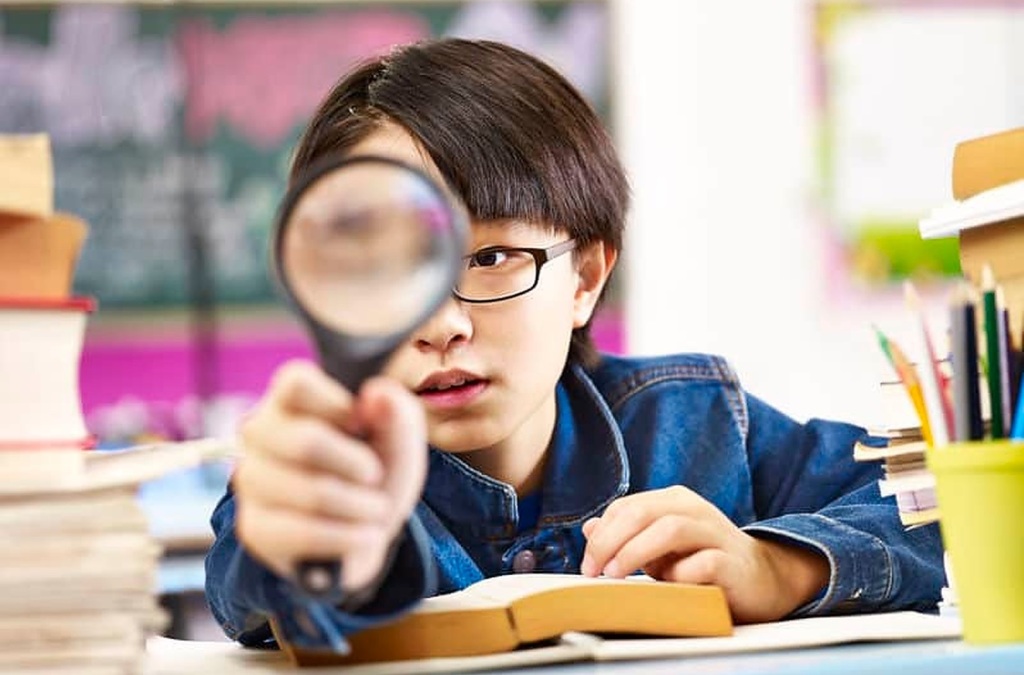
by Kenneth Lyen
Introduction
“I brought my 6-year-old son to see you because his teacher says he has attention deficit hyperactivity disorder (ADHD)”, an anxious mother told me. “He cannot sit still, keeps on interrupting the teacher by asking endless questions, and does not pay attention, reading books all the time.” I asked mother what her son was particularly interested in, and the boy immediately barged in saying he was interested in the ice tundra, astronomy, dinosaurs, and Harry Potter books. All the while, he was fidgeting in his chair, twirling round and round. His mother told him that despite getting bad reports from the teachers, he always did well in mathematics and other tests.
I referred him for formal psychological testing and the report said that this boy did not have ADHD, but rather he had gifted intelligence. His behaviour was overactive, not hyperactive, probably because he was able to learn things very quickly, and got bored in class when lessons dragged on at a snail’s pace.
Definitions
There are many adjectives we use to describe intelligent people, such as “clever”, “smart”, “bright”, “brainy”, scholarly. Some intelligent people are especially talented in certain areas, like mathematics, language, music, art and sports. Does that mean there are many types of intelligences? And what is the relationship between giftedness and intelligence? And how does giftedness differ from talent? First, let us try to define these concepts.
Intelligence
Intelligence can be defined as a general mental aptitude that involves several capabilities, including the abilities to reason, to solve problems, to think abstractly, plan ahead, learn from experience, understand and memorize complex ideas.
Intelligence can be measured by an IQ test. However, this is limited to mathematics, visuospatial and language measurements, but it appears that there appears to be a general factor (g factor) which crosses into other assessments of intelligence (see below for IQ tests).
Giftedness
Giftedness is a quality or attribute where a person displays exceptionally high achievement capabilities in areas of intellectual, creative, artistic, leadership capacity, or in specific academic fields.
Children may be born with the potential of developing giftedness. In other words, there is a gifted genetic seed which can grow and flourish best when given the right nourishing environment.
Giftedness is usually linked to a high intelligence, with an IQ of 130 or higher, which is found in the top 2% of the general population.
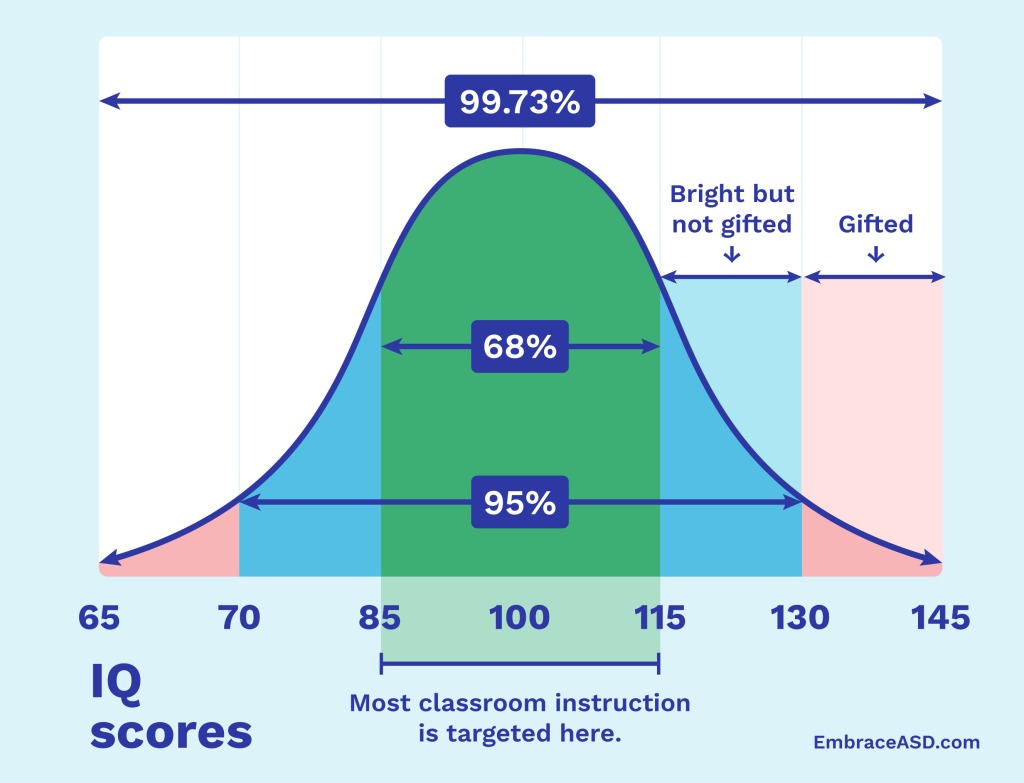
Talented
To be talented is to have the natural ability or skill to do something very well. Often the areas of ability are in the arts, sports, and school performance.
Gifted vs Talented
The major differences are that gifted people display outstanding natural abilities and exceptional talents. There are far fewer gifted people in the general population. Talented individuals are also very skillful and have brilliant abilities in many areas including dance, music, design, sports, writing, and arts. Gifted people tend to think differently, and are more driven. However, there is some overlap between gifted and talented persons. Major differences are outline in the table below:
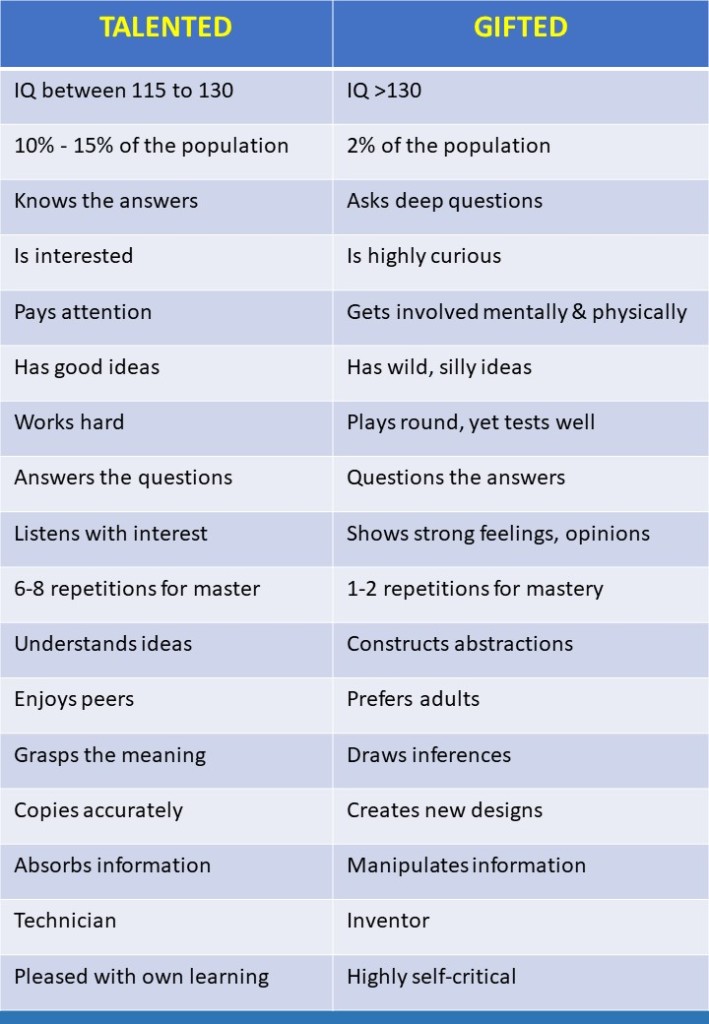
IQ Tests and the Labeling of Giftedness
Despite the limitations, the most objective tests for diagnosing giftedness is the IQ intelligence test. The Stanford-Binet test was developed by Lewis Terman, the professor of psychology at Stanford University, in 1917. It was modified from the original Binet-Simon test (1905), and remains the foundation of current IQ tests.
Since then, there have been many more IQ tests developed. For children, the most popular is the Wechsler Intelligence Scale for Children.
For entry into many educational programs, the IQ test forms an important component of the entrance exams. For example, entry into the Singapore secondary schools requires students to sit for the Primary School Leaving Exam (PSLE). For university entry, the US universities have a Scholastic Assessment Test (SAT), the British medical schools’ tests include the University Clinical Aptitude Test (UCAT), the BioMedical Admissions Test (BMAT), and for international students applying to Australian medical schools, they have to take the International Student Admissions Test (ISAT). A major component of all these exams is the IQ test.
Gifted Education

It has long been recognised that some gifted children have difficulties negotiating the conventional educational system. Their minds are racing ahead, but they are dragged back by their slower classmates. Therefore, many countries offer education for gifted children on a voluntary basis.
In order to be admitted into such a program, children have to take a special exam, which includes an IQ test.
In Singapore, the top 1% of that year’s cohort are admitted to the gifted program. IQ forms the major component of the selection criteria. Although the actual IQ might fluctuate from year to year, in general the gifted program selects children whose IQ are greater than around 140. The test is taken when the child is 9-10 years old.
There has been a lot of debate concerning gifted education. The first is the use of IQ tests for admission into the program. Below are listed the pros and cons of using IQ tests to select students:
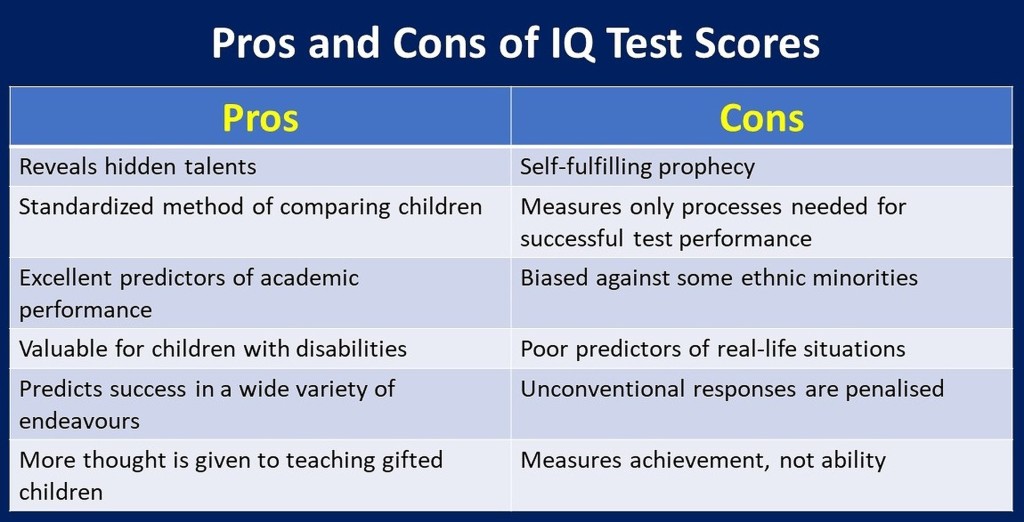
Interviewing children and parents who have been through gifted educational programs, the general consensus is that the benefits of the gifted education system outweigh the risks of remaining in a regular mixed ability class. Most children enjoy the program, they like to mix with children of similar intellect, they love being taught by better teachers, being stretched academically, and covering the curriculum at a greater depth. The majority of these gifted children continue to do well right through university and their chosen future professions.
One of the recurring objections to the gifted education program is that it creates a class of elites. One teenager in the gifted education program was asked if she knew a child attending a normal class in her school, and she answered: “I do not mix with normal students”! To minimise this concern of superiority and elitism, many gifted education programs try their best to integrate the children of all abilities to participate together in non-academic areas including art, music, drama, sports, and community service.
Some critics say that not all gifted children remain gifted throughout their lives. This criticism has been tackled by allowing free flow of gifted children in and out of the program. Singapore only accepts children in the top 1% of the population into the gifted program, and both the child and the parents must accept the opportunity being offered; thus reducing the possibility of making wrong admission choices.
If a child is gifted in a narrow area, such as language, mathematics or science, there may some pressure by the parents to try to accelerate the learning in these areas. Promoting the child to an older class can potentially create some problems. Children develop different skills at different rates, and this is referred to as asynchronous development. For example, an 8-year-old child may have the language ability of a 14-year-old, and if they join a class of older children, their social and emotional development may be out of synchrony with the older children. One solution of this dilemma is to have special individual tuition devoted to the academic areas appropriate for that child.
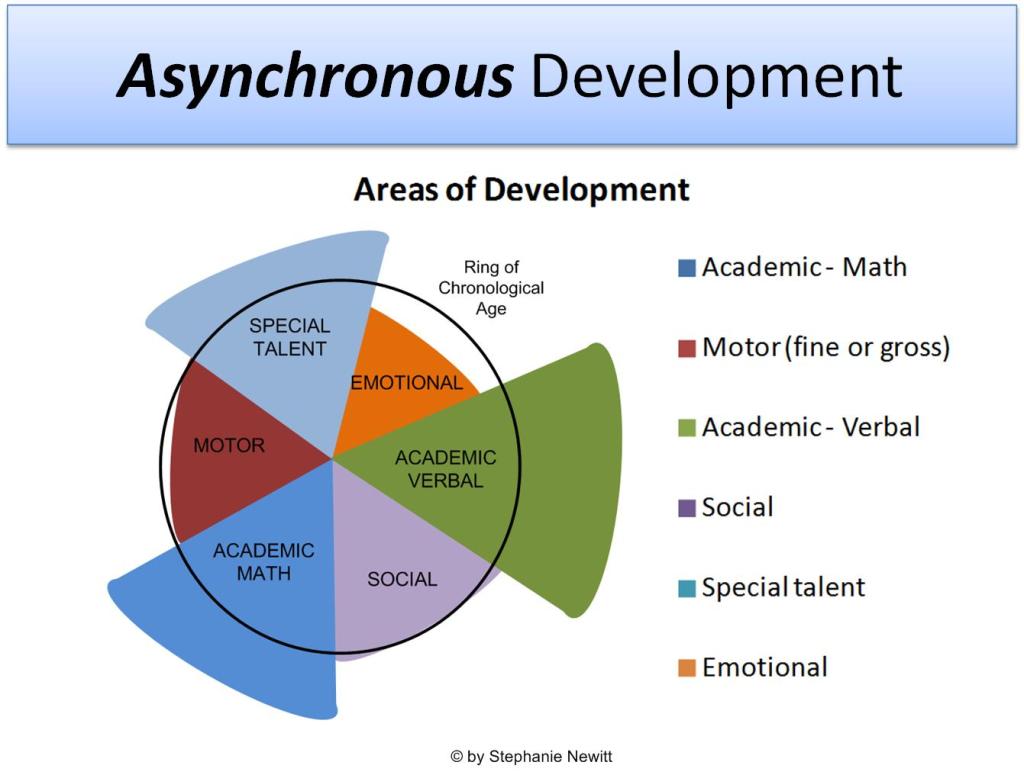
A flexible individualised educational system is recommended. With technological advances in education, perhaps this pipe dream may be realised in the near future.
Multiple Intelligences
Another criticism of using conventional IQ tests for selecting students for the gifted education program is that it assesses a relatively narrow range of abilities, namely mathematics, language, and visuospatial. Howard Gardner originally suggested 7 intelligences in 1983, but he has increased this number to 9. They include:
- Visual-spatial
- Linguistic-verbal
- Logical-mathematical
- Bodily-kinesthetic
- Musical
- Interpersonal
- Intrapersonal
- Naturalistic
- Existential
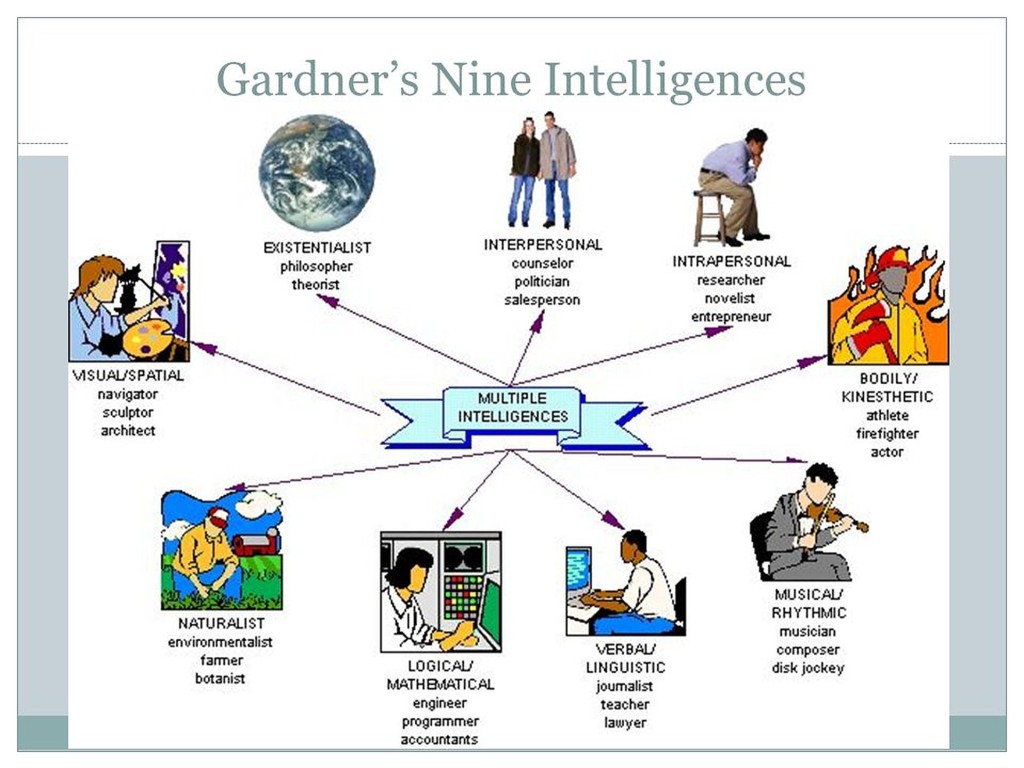
If we look at education more holistically, then gifted children who excel in only a few areas, should nevertheless be given the opportunity to explore other areas.
Problems of Gifted Children
Parents seek medical or psychological consultation for their gifted child because they might develop some challenges related or arising from their giftedness. These problems can arise not only in gifted students attending non-gifted classes, but also in those going to gifted classes. The problems include:
a) Attention Deficit Hyperactivity Disorder (ADHD)
The 6-year-old boy described in the opening paragraph, is one such example. The psychologist did a formal assessment, and found that he did not have ADHD, but instead he was gifted. The explanation of the restless behaviour, failure to pay attention, and his constantly interrupting the teacher, is attributed to his amazingly fast ability to learn. The teacher caters to the average student, and spends longer repeating the lesson, which bores the gifted student.
b) Disruptive Behaviour and Poor Social Skills
Some gifted children get so fed up with the slow pace of the teaching that they engage in other activities, like chatting with their neighbours. Others are perfectionists and keep on correcting their teachers or classmates when they say something deemed incorrect. Some gifted children have poor social skills and do not know how to interact with their peers. They may be perceived by their peers to be egoistical or arrogant, and this can lead to arguments, fights, and ostracization.
c) Depression
Depression and suicides are found in gifted children, but it is controversial whether or not it is more frequent in gifted children compared to their age-matched non-gifted peers. It has been suggested that gifted children are more prone to depression and suicide because they have heightened sensitivities, they tend to be introverted, overachieving perfectionists, or they become extremely worried if they do not fulfil their self-imposed high standards, and they may be prone to bullying by their non-gifted peers.
d) Twice-Exceptional
The term twice-exceptional refers to a person who is both gifted as well as being disabled. For example, it may be a person who has a very high IQ and is also autistic. The special needs may be a learning disability, dyslexia, attention deficit hyperactivity disorder, visual or hearing impairment, or motor deficits. If their accompanying disability is missed or ignored, these talented children may be under a lot of pressure, may lose motivation and therefore under-achieve.
Terman’s Termites
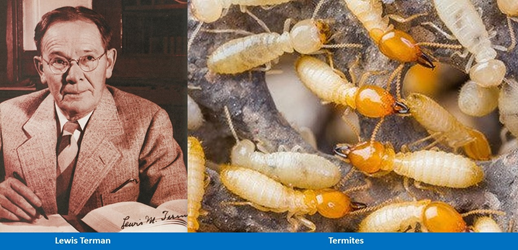
Lewis Terman (1877-1956) was the founder of the Stanford-Binet IQ test, which was introduced in 1916. In 1921 he began a longitudinal genetic study of highly gifted children, which were later dubbed as “Terman’s Termites”. They were followed up until they reached 70 to 80 years of age. Altogether he recruited 1,528 participants between the ages of 3 to 28, who had an IQ of >135, comprising 1% of the general population, which he defined as “genius”. There were 856 boys and 672 girls, mostly from California, and they were predominantly white and middle class. The finding was summarised as: “the gifted child becomes the gifted adult”. His Termites had ten times the national rate of earning a university bachelor’s degree of that era. A significant number of graduates went on to earn postgraduate degress: 57 doctors, 92 lawyers, and 97 PhD’s which was a high percentage of that time period. The salaries of his Termites was also significantly higher than the matched median per capita income.
It is of interest to note that two subjects rejected by Terman because their IQ fell below 135, went on to win a Nobel Prize each. Hence the joke suggesting that if you want to win a Nobel Prize, you should not have too high an IQ!
Lewis Terman recommended helping highly gifted children with special gifted education, trained teachers, employing enriched and accelerated curriculum. The benefits of this approach has been vindicated by more recent studies in several other countries.
Contemporary Gifted Persons

William James Sidis enrolled in Harvard University at the age of 9 years. He predicted the existence of regions of space where the second law of thermodynamics operated in reverse to the temporal direction.
Christopher Michael Hirata won the International Physics Olympiad at the age of 13 and graduated from Caltech at the age of 18. He is a leading exponent of precision cosmology, combining interdisciplinary computer studies, theoretical studies, and observational astronomy. His achievements are in the field of dark energy and the accelerating expansion of the universe.
Christopher Langan obtained a perfect SAT score but dropped out of university because he could teach his professors more than they could teach him. Langan has developed an idea he calls the “Cognitive-Theoretic Model of the Universe” which he maintains “explains the connection between mind and reality”.

Terence Tao is an Australian-American whose Hong Kong parents emigrated to Australia. He attended a university mathematics course at the age of 8 years, and co-authored over 300 research papers, including formulating the Green-Tao theorem for which he was awarded the Field Medal, which is considered the mathematics equivalent of the Nobel Prize. He is also referred to as the “Mozart of Maths”.
Kim Ung-Yong got his PhD degree at the age of 8 years. At the age of 15, he was doing research work for the National Aeronautics and Space Administration (NASA). He is currently the Vice President of North Kyeong-gi Development Research Center.
Philip Emeagwali is a Nigerian computer scientist whose simulation was the first program to apply a pseudo-time approach to reservoir modeling. At the age of 35 he received the Gordon Bell Prize for an application of the CM-2 massively-parallel computer.
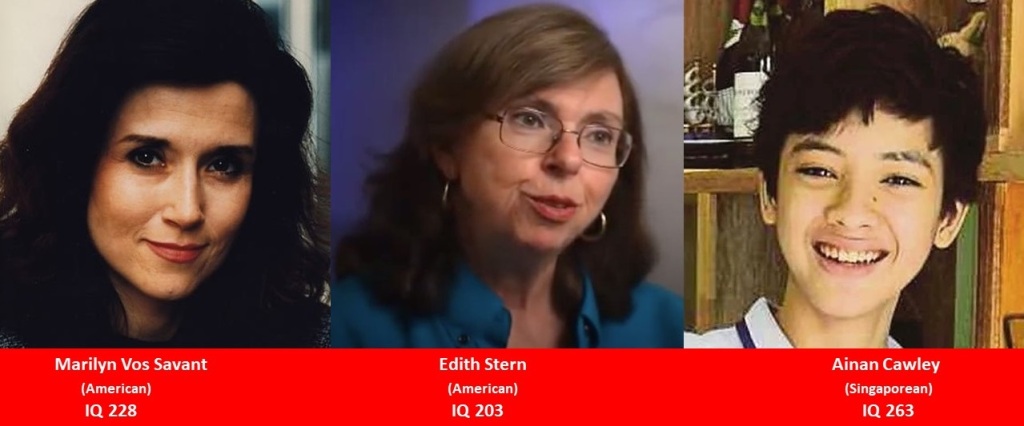
Marilyn Vos Savant is an American magazine columnist, author, lecturer, and playwright.
Edith Stern graduated from university at the age of 15 and is an American inventor and mathematician. She holds over 100 USA patents, and was the former Vice-President for Research and Development at IBM.
Ainan Cawley is a Singaporean living in Malaysia. At the age of 8 years, he was attending a chemistry course at the Singapore Polytechnic, and at 9 years of age, he could memorize π (pi) to the first 518 decimal places. At the age of 12 he wrote the script and composed the music for a short film.
Conclusions
Gifted children are valuable human resources for any country. If nurtured appropriately and allowed to reach their maximum potential, they can contribute to the future of their country and the world.

References
Wikipedia. Intellectual giftedness.
https://en.wikipedia.org/wiki/Intellectual_giftedness
National Association for Gifted Children (USA). What is giftedness?
https://www.nagc.org/resources-publications/resources/what-giftedness
Davidson Institute. What is giftedness?
https://www.davidsongifted.org/gifted-blog/what-is-giftedness/
Wai J. What a century of research reveals about gifted kids.
https://www.psychologytoday.com/sg/blog/finding-the-next-einstein/201701/what-century-research-reveals-about-gifted-kids
Ministry of Education Singapore. Gifted education programme.
https://www.moe.gov.sg/programmes/gifted-education
Wikipedia. Gifted education programme (Singapore).
https://en.wikipedia.org/wiki/Gifted_Education_Programme_(Singapore)
Neihart M, Teo CT. Addressing the needs of the gifted in Singapore.
file:///D:/Medicine/Gifted/Gifted%20Education/Singapore%20Gifted%20Education%201.pdf
Neihart M, Tan LS. Gifted education in Singapore.
file:///D:/Medicine/Gifted/Gifted%20Education/Singapore%20Gifted%20Education%202.pdf
Eren F et al. Emotional and behavioral characteristics of gifted children and their families.
https://www.ncbi.nlm.nih.gov/pmc/articles/PMC6060660/
Page JS. Challenges faced by “gifted learners” in school and beyond.
http://www.inquiriesjournal.com/articles/330/challenges-faced-by-gifted-learners-in-school-and-beyond
Gaille B. 15 Intelligence testing pros and cons
https://brandongaille.com/15-intelligence-testing-pros-and-cons/
Wikipedia. Theory of multiple intelligences.
https://en.wikipedia.org/wiki/Theory_of_multiple_intelligences
Transformations. Unexpected consequences of growing up gifted.
https://www.mytransformations.com/post/unexpected-consequences-of-growing-up-gifted
Warne RT. An evaluation (and vindication?) of Lewis Terman.
https://journals.sagepub.com/doi/pdf/10.1177/0016986218799433
Freeman J. Giftedness in the long term.
https://files.eric.ed.gov/fulltext/EJ746289.pdf
Written by Kenneth Lyen 19 July 2021
You must be logged in to post a comment.